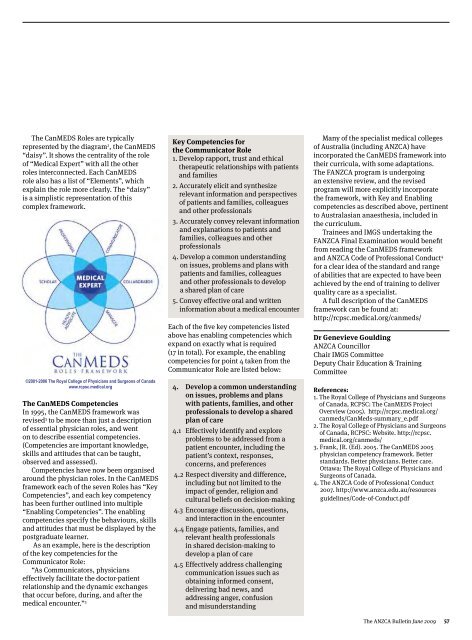ANZCA Bulletin - June 2009 - Australian and New Zealand College ...
ANZCA Bulletin - June 2009 - Australian and New Zealand College ...
ANZCA Bulletin - June 2009 - Australian and New Zealand College ...
- No tags were found...
Create successful ePaper yourself
Turn your PDF publications into a flip-book with our unique Google optimized e-Paper software.
The CanMEDS Roles are typicallyrepresented by the diagram 2 , the CanMEDS“daisy”. It shows the centrality of the roleof “Medical Expert” with all the otherroles interconnected. Each CanMEDSrole also has a list of “Elements”, whichexplain the role more clearly. The “daisy”is a simplistic representation of thiscomplex framework.©2001-2006 The Royal <strong>College</strong> of Physicians <strong>and</strong> Surgeons of Canadawww.rcpsc.medical.orgThe CanMEDS CompetenciesIn 1995, the CanMEDS framework wasrevised 3 to be more than just a descriptionof essential physician roles, <strong>and</strong> wenton to describe essential competencies.(Competencies are important knowledge,skills <strong>and</strong> attitudes that can be taught,observed <strong>and</strong> assessed).Competencies have now been organisedaround the physician roles. In the CanMEDSframework each of the seven Roles has “KeyCompetencies”, <strong>and</strong> each key competencyhas been further outlined into multiple“Enabling Competencies”. The enablingcompetencies specify the behaviours, skills<strong>and</strong> attitudes that must be displayed by thepostgraduate learner.As an example, here is the descriptionof the key competencies for theCommunicator Role:“As Communicators, physicianseffectively facilitate the doctor-patientrelationship <strong>and</strong> the dynamic exchangesthat occur before, during, <strong>and</strong> after themedical encounter.” 3Key Competencies forthe Communicator Role1. Develop rapport, trust <strong>and</strong> ethicaltherapeutic relationships with patients<strong>and</strong> families2. Accurately elicit <strong>and</strong> synthesizerelevant information <strong>and</strong> perspectivesof patients <strong>and</strong> families, colleagues<strong>and</strong> other professionals3. Accurately convey relevant information<strong>and</strong> explanations to patients <strong>and</strong>families, colleagues <strong>and</strong> otherprofessionals4. Develop a common underst<strong>and</strong>ingon issues, problems <strong>and</strong> plans withpatients <strong>and</strong> families, colleagues<strong>and</strong> other professionals to developa shared plan of care5. Convey effective oral <strong>and</strong> writteninformation about a medical encounterEach of the five key competencies listedabove has enabling competencies whichexp<strong>and</strong> on exactly what is required(17 in total). For example, the enablingcompetencies for point 4 taken from theCommunicator Role are listed below:4. Develop a common underst<strong>and</strong>ingon issues, problems <strong>and</strong> planswith patients, families, <strong>and</strong> otherprofessionals to develop a sharedplan of care4.1 Effectively identify <strong>and</strong> exploreproblems to be addressed from apatient encounter, including thepatient’s context, responses,concerns, <strong>and</strong> preferences4.2 Respect diversity <strong>and</strong> difference,including but not limited to theimpact of gender, religion <strong>and</strong>cultural beliefs on decision-making4.3 Encourage discussion, questions,<strong>and</strong> interaction in the encounter4.4 Engage patients, families, <strong>and</strong>relevant health professionalsin shared decision-making todevelop a plan of care4.5 Effectively address challengingcommunication issues such asobtaining informed consent,delivering bad news, <strong>and</strong>addressing anger, confusion<strong>and</strong> misunderst<strong>and</strong>ingMany of the specialist medical collegesof Australia (including <strong>ANZCA</strong>) haveincorporated the CanMEDS framework intotheir curricula, with some adaptations.The F<strong>ANZCA</strong> program is undergoingan extensive review, <strong>and</strong> the revisedprogram will more explicitly incorporatethe framework, with Key <strong>and</strong> Enablingcompetencies as described above, pertinentto Australasian anaesthesia, included inthe curriculum.Trainees <strong>and</strong> IMGS undertaking theF<strong>ANZCA</strong> Final Examination would benefitfrom reading the CanMEDS framework<strong>and</strong> <strong>ANZCA</strong> Code of Professional Conduct 4for a clear idea of the st<strong>and</strong>ard <strong>and</strong> rangeof abilities that are expected to have beenachieved by the end of training to deliverquality care as a specialist.A full description of the CanMEDSframework can be found at:http://rcpsc.medical.org/canmeds/Dr Genevieve Goulding<strong>ANZCA</strong> CouncillorChair IMGS CommitteeDeputy Chair Education & TrainingCommitteeReferences:1. The Royal <strong>College</strong> of Physicians <strong>and</strong> Surgeonsof Canada, RCPSC: The CanMEDS ProjectOverview (2005). http://rcpsc.medical.org/canmeds/CanMeds-summary_e.pdf2. The Royal <strong>College</strong> of Physicians <strong>and</strong> Surgeonsof Canada, RCPSC: Website. http://rcpsc.medical.org/canmeds/3. Frank, JR. (Ed). 2005. The CanMEDS 2005physician competency framework. Betterst<strong>and</strong>ards. Better physicians. Better care.Ottawa: The Royal <strong>College</strong> of Physicians <strong>and</strong>Surgeons of Canada.4. The <strong>ANZCA</strong> Code of Professional Conduct2007. http://www.anzca.edu.au/resourcesguidelines/Code-of-Conduct.pdfThe <strong>ANZCA</strong> <strong>Bulletin</strong> <strong>June</strong> <strong>2009</strong> 57
















